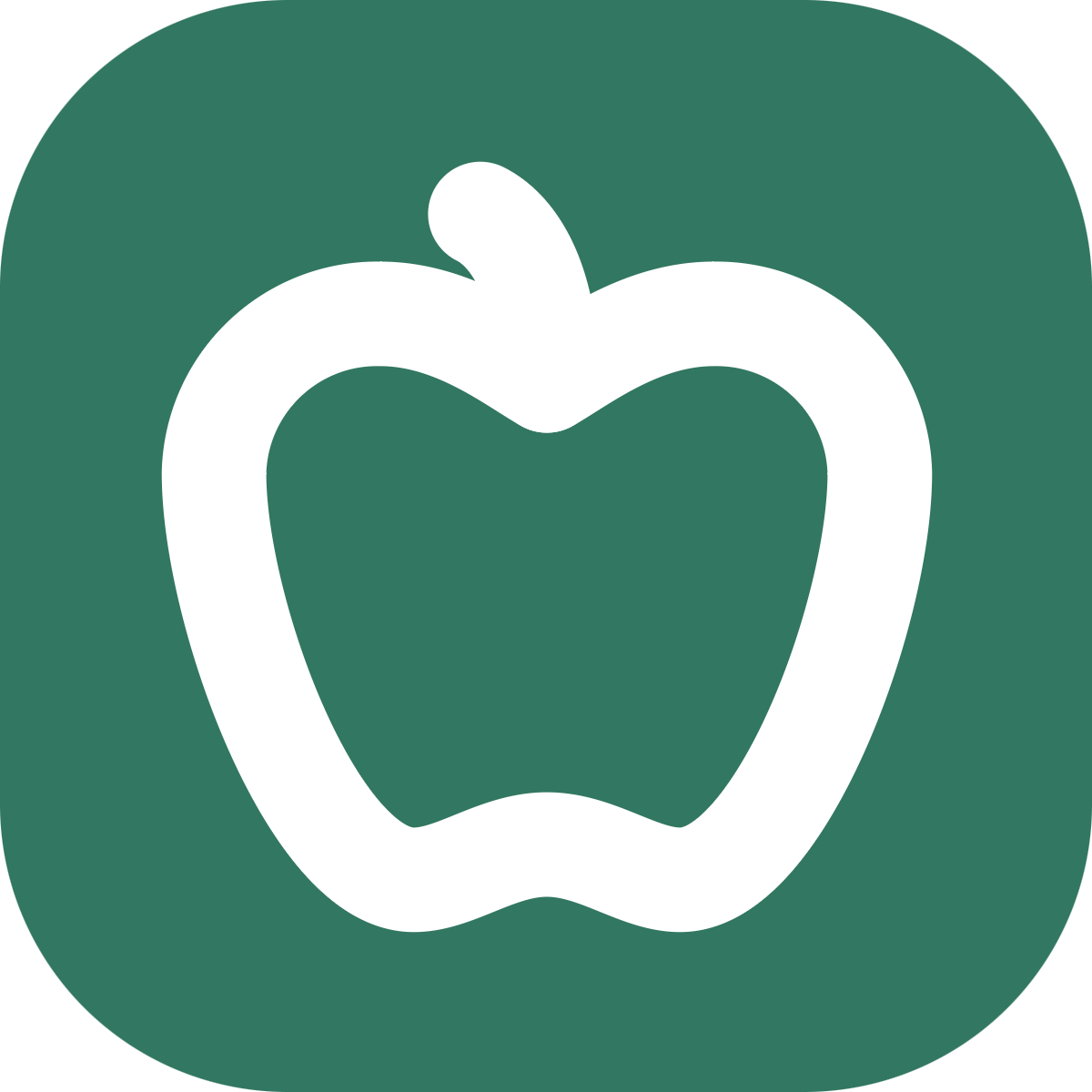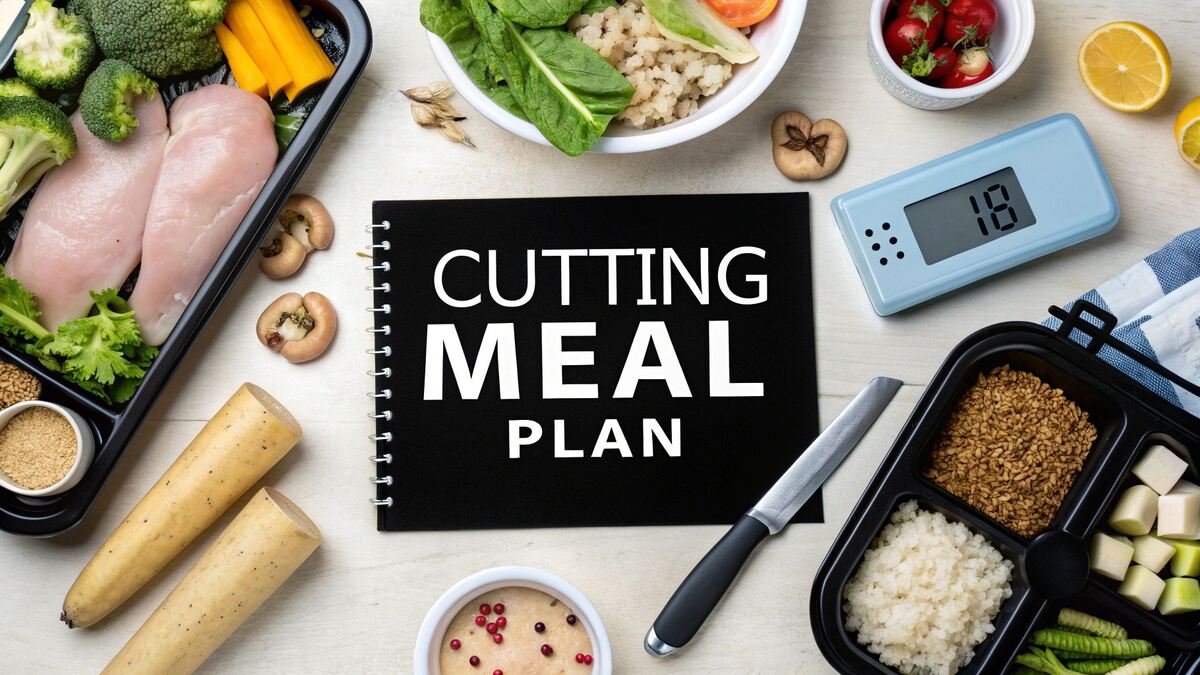Your Ultimate Cutting Diet Meal Plan for Fat Loss
A successful cutting diet is all about strategy. It’s a targeted approach to fat loss that hinges on creating a caloric deficit without sacrificing the muscle you’ve worked so hard to build. Forget starving yourself; this is about precision nutrition, giving your body exactly what it needs to burn fat efficiently. The whole game plan is built on getting your calorie count right, balancing your macros, and thinking about nutrient timing.
Building the Foundation of Your Cut
Before you even think about writing a grocery list or looking up recipes, we need to lay the groundwork. Just “eating less” isn’t a plan—it’s a fast track to losing muscle and getting frustrated. A proper cut is a more scientific process. The goal is to nudge your body into a fat-burning state while signaling it to hang onto your lean muscle mass.
Getting this foundation right is what separates a draining, short-lived diet from a sustainable transformation that actually delivers the results you want.
This infographic breaks down the essential steps to get you started.
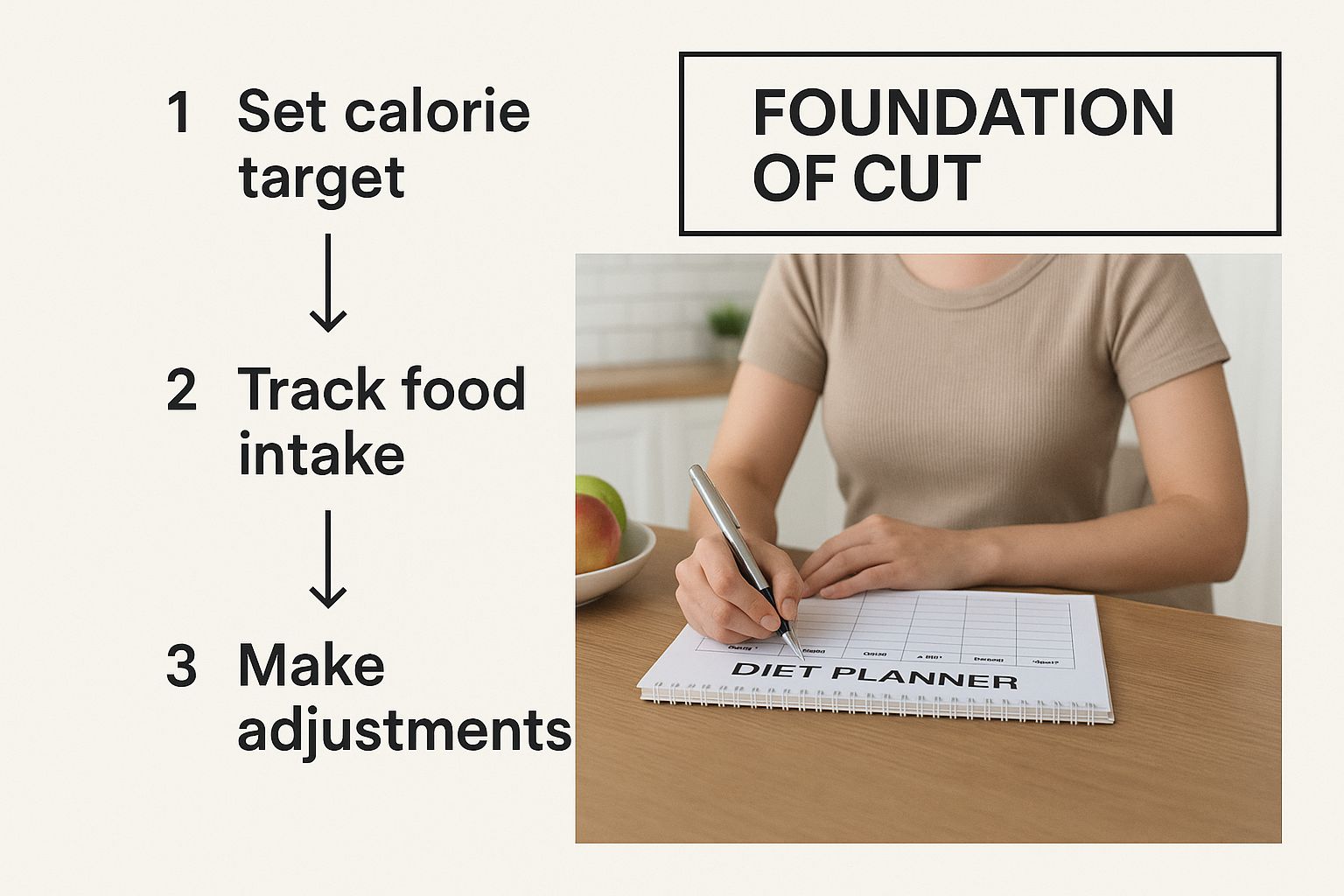
Seeing the entire process, from setting your goals to planning your meals, helps highlight how each piece connects to form a solid, effective strategy.
The Science of a Caloric Deficit
At the heart of any fat loss plan is one core principle: the caloric deficit. It’s simple, really. You just need to consistently eat fewer calories than your body uses for energy. When your body doesn’t get enough fuel from food to power everything from your workouts to just breathing, it has to tap into its stored energy—and that's primarily your body fat.
But creating this deficit is a balancing act. You can’t just slash calories drastically. The sweet spot for most people is a moderate deficit of around 300-500 calories below your daily maintenance level. This encourages your body to use fat for fuel without freaking out and entering a "starvation mode," which can tank your metabolism and start breaking down muscle tissue.
Setting Realistic and Sustainable Goals
One of the biggest pitfalls I see is people setting wildly unrealistic goals. Trying to drop ten pounds in a week isn't just unhealthy; it's a guaranteed way to burn out and give up. A safe, sustainable, and realistic rate of fat loss is about 1-2 pounds per week.
Instead of getting obsessed with the number on the scale, try setting goals based on your performance and habits.
- Be Consistent: Aim to nail your calorie and protein targets six out of seven days a week. Nobody's perfect, but consistency wins.
- Maintain Performance: A huge indicator of muscle preservation is maintaining your strength in the gym. Focus on that.
- Stick to the Plan: Commit to your cutting diet for a set timeframe, like 12 weeks, before you make any major judgments or changes.
A well-structured cut isn't a sprint; it's a marathon with a clear finish line. Your mindset and goal-setting strategy are just as important as the food on your plate.
The Three Pillars of an Effective Cut
Every single successful cutting plan I've ever seen or created is built on three fundamental pillars. Get these right, and you'll have the structure you need for predictable, consistent results.
- Precise Calorie Control: This is the one non-negotiable. You have to know your numbers. Figure out your maintenance calories and your target deficit to ensure you're consistently in a position to lose fat.
- Smart Macronutrient Ratios: Not all calories are the same. A high-protein diet is absolutely critical for holding onto muscle. Carbs are essential for fueling your workouts, and healthy fats play a key role in hormone function.
- Strategic Nutrient Timing: While it’s not as crucial as your total daily intake, when you eat can make a difference. Timing your carbs around your workouts, for example, can give you a noticeable boost in performance and recovery.
Once you truly understand these fundamentals, you’re empowered to build a plan that not only works but is also designed specifically for your body and your lifestyle.
Dialing in Your Personal Calorie and Macro Needs
A one-size-fits-all cutting plan might get you started, but it won't get you to the finish line. True progress comes from tailoring your nutrition to your body. Your age, activity level, and unique metabolism all play a role, so let's stop guessing and start building a blueprint that actually works for you.
First thing’s first: you need to figure out your Total Daily Energy Expenditure (TDEE). Think of this as your body's daily "calorie budget." It’s the total number of calories you burn just living your life—from intense workouts to basic functions like breathing.
There are plenty of free TDEE calculators online that will give you a solid estimate. Just plug in your details, and you’ll get a baseline number for your maintenance calories—what you need to eat to stay at your current weight.
Creating the Right Caloric Deficit
Once you know your TDEE, the next step is to create a smart, sustainable calorie deficit. This is what signals your body to start burning fat for fuel. The key here is to be strategic, not drastic.
For most people, a deficit of 300-500 calories below your TDEE is the sweet spot. This gentle reduction encourages your body to use fat stores for energy without sending it into panic mode, which can lead to muscle loss and a stalled metabolism.
So, if your TDEE is 2,500 calories, your cutting target would land somewhere between 2,000 and 2,200 calories per day. This approach usually leads to a safe and steady weight loss of about 1 pound per week. A typical cutting phase can last anywhere from 4 to 24 weeks, giving you enough time to achieve significant fat loss while protecting that hard-earned muscle.
Setting Your Macronutrient Targets
Calories are just one part of the equation. Where those calories come from—your macronutrients (protein, carbs, and fats)—is what truly sculpts your physique. Just hitting a number isn't enough; the right macro split is what preserves muscle and powers your workouts.
Getting your macros right is the difference between simply losing weight and truly changing your body composition. Prioritizing protein is your number one defense against muscle loss during a cut.
Let's break down how to set up your macros for success.
1. Make Protein Your Priority
Protein is, without a doubt, the most important macro when you're cutting. It protects lean muscle mass, keeps you feeling full and satisfied, and even boosts your metabolism slightly because your body burns more calories digesting it.
- Your Goal: Aim for 1.0 to 1.2 grams of protein per pound of your target body weight.
- Example: If your goal is to be a lean 180 pounds, you'll want to shoot for 180-216 grams of protein every day. For some great meal ideas to hit this number, check out our guide to high-protein meal plans.
2. Don't Fear the Fat
Cutting fats too low is a classic mistake. Dietary fats are absolutely essential for healthy hormone production—including testosterone, which is critical for maintaining muscle mass.
- Your Goal: Allocate 20-30% of your total daily calories to healthy fats.
- Example: On a 2,200-calorie diet, that’s 440-660 calories from fat. Since fat has 9 calories per gram, you're looking at about 49-73 grams of fat per day.
3. Fill the Gaps with Carbs
Carbohydrates are your body’s preferred fuel source, especially for powering you through tough workouts. After you've set your protein and fat goals, the rest of your calorie budget goes to carbs.
- Your Goal: Use your remaining calories for carbohydrates.
- Example: Let's put it all together with our 2,200-calorie plan:
- Protein: 180g x 4 cal/g = 720 calories
- Fat: 60g x 9 cal/g = 540 calories
- Remaining Calories for Carbs: 2,200 - 720 - 540 = 940 calories
- Total Carbs: 940 calories / 4 cal/g = 235 grams of carbohydrates
Once you have your personal numbers figured out, you might find that your favorite recipes don't quite fit your new targets. This is where a little kitchen know-how comes in handy. A great next step is to learn how to scale recipes so you can easily adjust meals to hit your macros perfectly, keeping your diet both effective and enjoyable.
Stocking Your Kitchen For Cutting Success
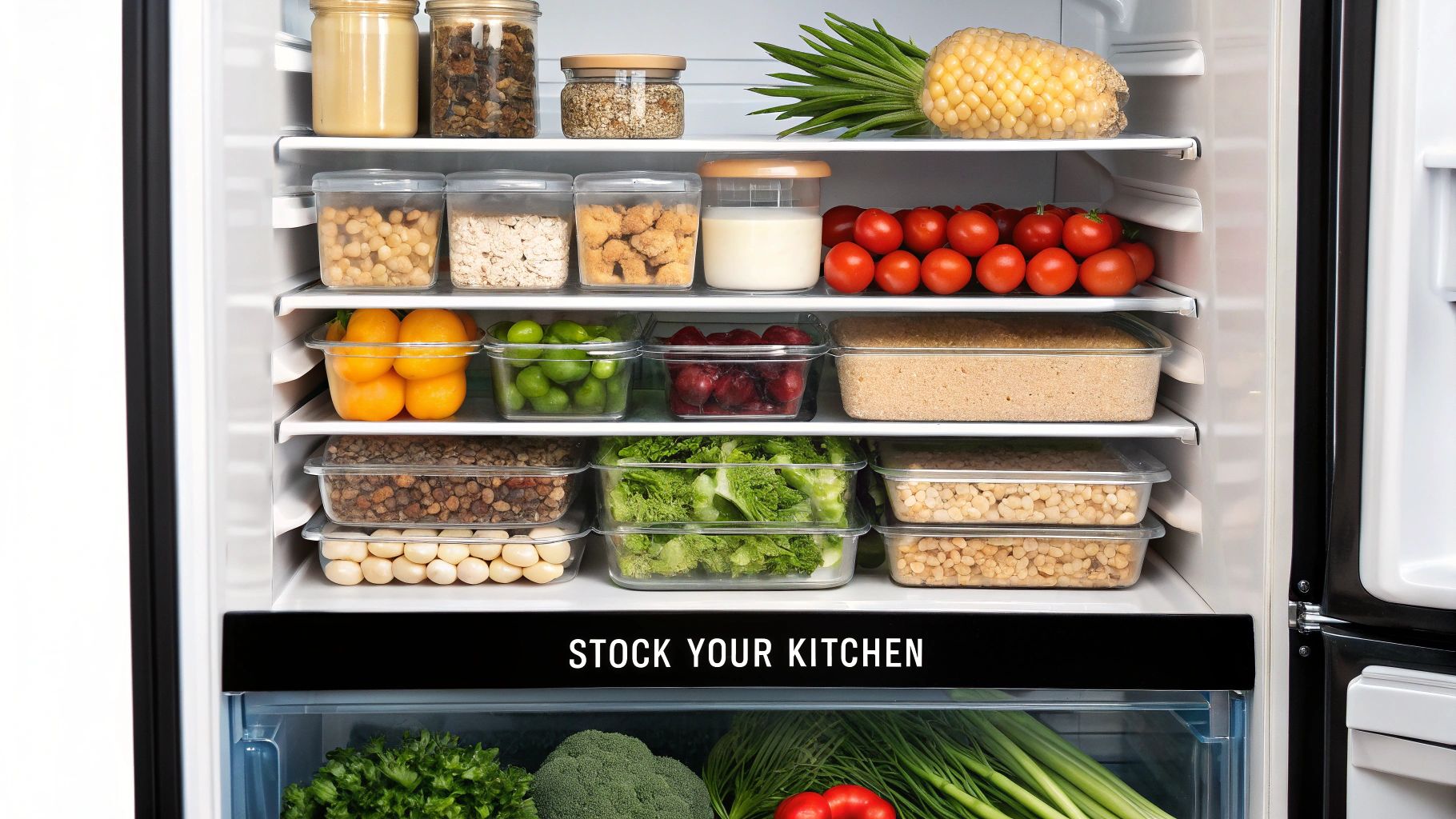
Alright, you’ve got your numbers—your personal calorie and macro targets are set. Now for the fun part: turning those numbers into actual food. A successful cut isn’t won through sheer willpower. It’s won in the kitchen.
Having the right foods on hand makes sticking to your plan almost effortless. This is where you set yourself up for success, long before hunger has a chance to make you reach for something you'll regret.
Let's be clear: we've come a long way from the old-school, ultra-restrictive cutting diets. The modern approach, backed by solid research, is all about balance and sustainability. It’s less about what you can't eat and more about loading your kitchen with high-impact, nutrient-dense foods.
Building Your High-Protein Arsenal
Protein is your best friend during a cut. It's the key to holding onto that hard-earned muscle while you're stripping away fat. Your grocery list should be heavy on lean, high-quality protein sources that give you the most bang for your caloric buck.
I always tell my clients to mix it up. Eating the same thing every day is a recipe for boredom and falling off the wagon. A good mix of animal and plant-based proteins will keep your meals interesting and ensure you’re getting a full spectrum of amino acids.
Here are the staples I always have in my fridge:
- Lean Meats: You can't go wrong with chicken breast, turkey breast, and lean ground turkey (93/7 or leaner). They're incredibly versatile.
- Fish: Salmon is my go-to for its omega-3s, and canned light tuna is a lifesaver for a quick, cheap protein hit.
- Dairy & Eggs: Plain Greek yogurt, cottage cheese, and whole eggs are non-negotiable. They're perfect for breakfast, snacks, or even adding creaminess to savory dishes.
- Plant-Based Power: Lentils, chickpeas, black beans, and tofu are fantastic. They’re not just protein—they’re loaded with fiber that will keep you feeling full for hours.
Choosing Smart Carbohydrates For Energy
Carbs are not the enemy. Let me say that again: carbs are not the enemy. They’re your body’s preferred fuel source, especially for powering through tough workouts. The trick is to choose the right kind of carbs—the complex, slow-burning ones that give you steady energy without the crash.
Timing is everything here. I like to eat most of my carbs in the window around my workout, both before and after. This puts that fuel to work immediately for performance and recovery.
By prioritizing complex carbs and timing them effectively, you turn your food into functional fuel. This isn't just about hitting a number; it's about optimizing your body's ability to perform and recover while in a deficit.
Load up your cart with these:
- Whole Grains: Rolled oats, quinoa, and brown rice are the foundation for sustained energy.
- Starchy Vegetables: Sweet potatoes and butternut squash are delicious and packed with nutrients.
- Legumes: Beans and lentils pull double duty, offering both fiber-rich carbs and a solid dose of protein.
- Fruits: Berries, apples, and bananas are great for a quick pre-workout energy boost. If you're running a tighter ship on carbs, a good https://ai-mealplan.com/plans/low-carb can give you some great ideas.
Incorporating Healthy Fats For Hormonal Health
One of the biggest mistakes I see people make is cutting their fat intake too low. This is a huge mistake. Healthy fats are absolutely critical for keeping your hormones in check, absorbing certain nutrients, and just feeling good overall.
You want to focus on unsaturated fats from whole-food sources. Not only are they good for you, but they also make your food taste better and keep you satisfied, which makes the whole process so much more sustainable.
- Avocados: A fantastic source of monounsaturated fat and fiber. Add it to anything!
- Nuts and Seeds: Almonds, walnuts, chia seeds, and flax seeds are little nutritional powerhouses. Just watch your portion sizes.
- Oils: I use extra virgin olive oil for salads and dressings, and avocado oil for cooking since it handles heat better.
And since you’ll be cooking more, make sure you’re using the right equipment. A good guide to healthy cooking pans can be a game-changer. Having quality tools just makes the whole process smoother and more enjoyable.
To simplify your next grocery run, here’s a quick-glance table of the essentials.
Essential Foods for Your Cutting Diet
| Protein Source | Carbohydrate Source | Healthy Fat Source |
|---|---|---|
| Chicken/Turkey Breast | Rolled Oats | Avocado |
| Salmon/Tuna | Brown Rice | Almonds/Walnuts |
| Lean Ground Beef/Turkey | Quinoa | Olive Oil |
| Eggs/Egg Whites | Sweet Potatoes | Chia/Flax Seeds |
| Greek Yogurt/Cottage Cheese | Berries/Apples | Natural Peanut Butter |
| Tofu/Tempeh | Lentils/Chickpeas | Olives |
Think of this table as your blueprint. Mix and match from these columns, and you’ll have the foundation for countless healthy, satisfying meals that will keep you on track with your cutting goals.
A Flexible 7-Day Cutting Meal Plan Example
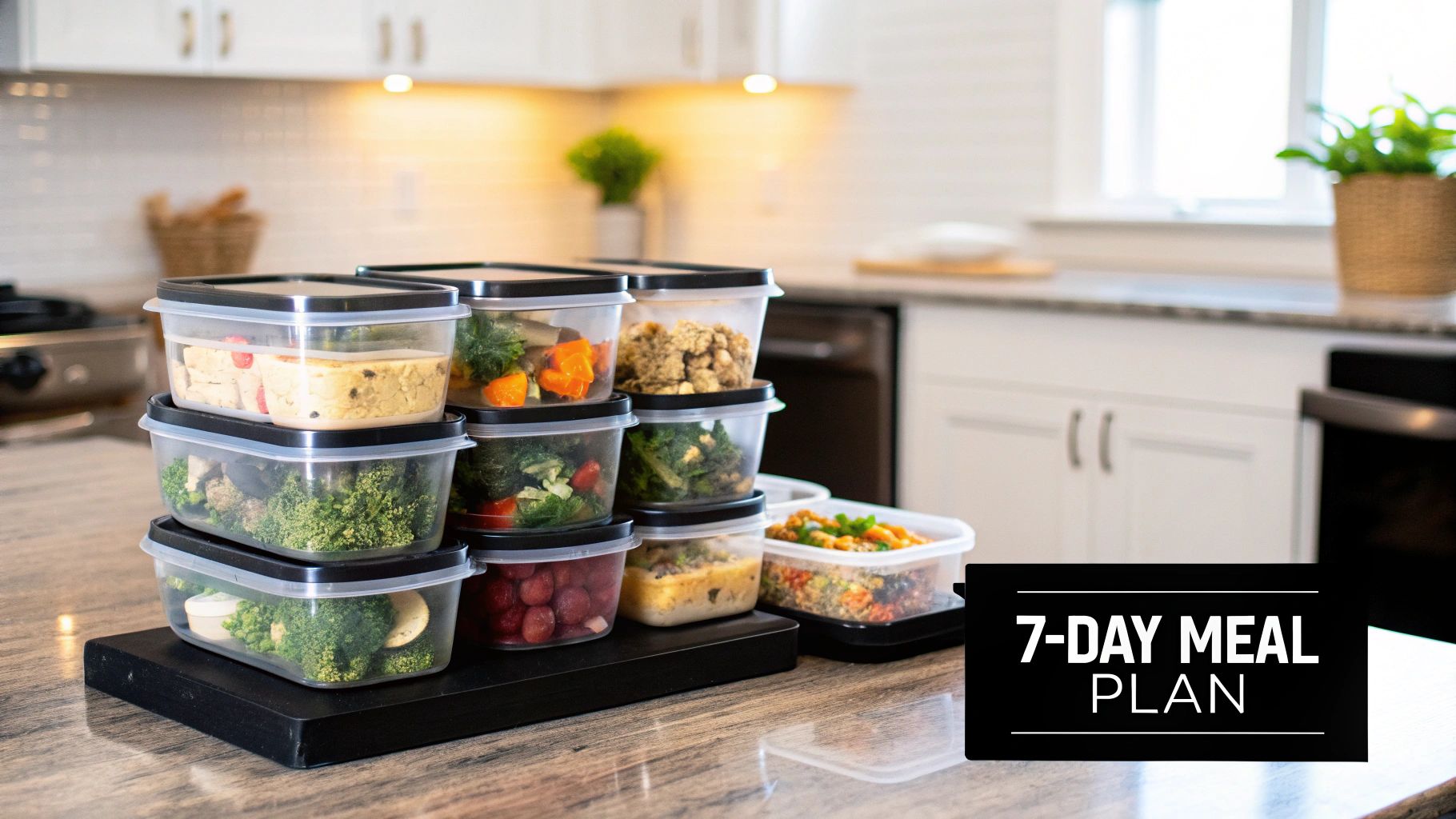
Alright, we've covered the numbers and the strategy. Now, let’s see what this looks like on a plate. Theory is great, but a concrete plan is what makes the difference between knowing what to do and actually doing it.
I’ve put together a sample week built around a 2,000-calorie target, which is a solid starting point for a lot of people.
Please, don't treat this as a rigid, must-follow-exactly-or-fail plan. Think of it as a template—a source of ideas you can tweak based on your own food preferences, schedule, and specific macros. The secret to sticking with a cut is making it your own.
Use this to get a feel for how to structure your meals, balance your macros throughout the day, and still eat food that's both satisfying and delicious. Swap out chicken for fish, broccoli for asparagus, or quinoa for brown rice. Keep it interesting.
Day 1: Monday
Kick off the week strong with simple, clean meals that are a breeze to prep.
- Breakfast (450 calories): Scrambled eggs (3 whole, 2 whites) with a handful of spinach and half an avocado. Serve it up with a slice of whole-wheat toast.
- Lunch (500 calories): 6 oz grilled chicken breast, 1 cup of cooked quinoa, and a big mixed greens salad with a light vinaigrette.
- Dinner (550 calories): 6 oz baked salmon with a cup of roasted broccoli and one medium sweet potato.
- Snack (500 calories): A protein shake (1 scoop whey in water), a crisp apple, and a handful of almonds (about 1 oz).
Day 2: Tuesday
Let's build on yesterday's momentum. We'll introduce some new flavors while keeping the macros right on track.
- Breakfast (400 calories): 1 cup of plain Greek yogurt mixed with a half-cup of berries and a tablespoon of chia seeds for some healthy fats and fiber.
- Lunch (550 calories): Leftover salmon and roasted broccoli from last night. Meal prep is your best friend on a cut!
- Dinner (600 calories): Lean ground turkey stir-fry (6 oz of 93/7) with mixed bell peppers, onions, and snap peas. Serve it over 1 cup of brown rice.
- Snack (450 calories): 1 cup of cottage cheese with some sliced peaches and a small handful of walnuts.
Remember, consistency trumps perfection. If you have an off-meal, don't let it derail your entire day or week. Just get back on track with your next planned meal and keep moving forward.
Day 3: Wednesday
Mid-week is often where the grind sets in. We’re keeping the meals simple, satisfying, and easy.
- Breakfast (450 calories): Oatmeal (1/2 cup dry) made with water or unsweetened almond milk. Stir in one scoop of protein powder and top with a sliced banana.
- Lunch (500 calories): Big tuna salad. I use one can of tuna (in water), but mix it with Greek yogurt instead of mayo. Serve with whole-grain crackers and celery sticks.
- Dinner (600 calories): Lean steak (6 oz sirloin, trimmed of fat) with a side of asparagus and a small baked potato.
- Snack (450 calories): Two hard-boiled eggs and a pear.
Day 4: Thursday
By this point in the week, having some prepped ingredients in the fridge makes staying on plan so much easier.
- Breakfast (400 calories): A quick protein smoothie. Blend 1 scoop of protein, a big handful of spinach, 1/2 cup of frozen berries, and unsweetened almond milk.
- Lunch (550 calories): Leftover ground turkey stir-fry. It often tastes even better the next day.
- Dinner (600 calories): Chicken and veggie skewers (6 oz chicken with bell peppers, zucchini, and cherry tomatoes) served with 1 cup of couscous.
- Snack (450 calories): An apple sliced up with 2 tablespoons of natural peanut butter.
If you're looking for even more ideas to keep your meals from getting boring, checking out a well-structured balanced meal plan can give you a ton of inspiration.
Day 5: Friday
We're heading into the weekend, so let's stay focused with meals that are delicious and don't feel like you're on a diet.
- Breakfast (450 calories): Back to Monday's classic: scrambled eggs with spinach, avocado, and whole-wheat toast.
- Lunch (500 calories): Leftover chicken skewers and couscous. Simple and effective.
- Dinner (650 calories): Homemade turkey burgers! A 6 oz patty (93/7) on a whole-wheat bun with lettuce, tomato, and onion. Add a side salad.
- Snack (400 calories): That Greek yogurt bowl from Tuesday's breakfast. It's too good not to have again.
Day 6: Saturday
Weekends can throw a wrench in your plans, but having a solid game plan helps you stay in control.
- Breakfast (450 calories): Protein pancakes (I make mine with protein powder, oats, and egg whites) topped with fresh berries.
- Lunch (500 calories): A big "kitchen sink" salad. Just throw in mixed greens, the leftover turkey burger patty, any veggies you have, and a light dressing.
- Dinner (600 calories): Shrimp scampi, but with a twist. Use zucchini noodles instead of pasta, and toss with garlic, lemon, and a touch of olive oil.
- Snack (450 calories): A simple protein shake and another handful of almonds.
Day 7: Sunday
Use today to relax, enjoy your food, and maybe prep a few things for the week ahead.
- Breakfast (400 calories): Oatmeal with protein powder and banana. It’s a classic for a reason.
- Lunch (550 calories): Leftover shrimp and zucchini noodles from last night's dinner.
- Dinner (650 calories): Roasted chicken breast (6 oz) with a medley of roasted root vegetables like carrots, parsnips, and sweet potato.
- Snack (400 calories): Cottage cheese with sliced peaches. A perfect high-protein end to the day.
Strategies to Get Shredded Faster
So, you’ve got your cutting diet meal plan locked in. You're hitting your numbers, day in and day out. That's the foundation, but if you want to really speed things up and blast through those frustrating plateaus, there are a few extra levers you can pull.
Think of these as the finishing touches. Success isn't just about what’s on your plate; it’s about creating an environment where your body can burn fat as efficiently as possible, even when you're running on less fuel. A few smart, consistent habits here can make all the difference.
You’re Probably Not Drinking Enough Water
This sounds ridiculously simple, but it’s one of the most powerful tools you have. Water is your best friend during a cut. Forget everything else for a second and just focus on this: proper hydration is non-negotiable.
Even being slightly dehydrated can slam the brakes on your metabolism. Your body needs water for just about every process it performs, especially tapping into fat stores for energy. Plus, it's a game-changer for managing hunger. Ever feel hungry and reach for a snack? Try chugging a big glass of water first. More often than not, you were just thirsty. Aiming for a gallon a day, sipped consistently, will keep you full and firing on all cylinders.
Don't Sleep on Your Micros
Everyone obsesses over protein, carbs, and fats. And they should. But when you’re cutting, your total food volume drops, which means your intake of vitamins and minerals—micronutrients—drops too. This is a rookie mistake you can’t afford to make.
These are the unsung heroes that keep the engine running smoothly. Without them, everything else falls apart.
- B Vitamins: These are your energy converters. They take the food you eat and turn it into fuel for your workouts.
- Iron: Essential for getting oxygen to your muscles. Low iron means poor performance, period.
- Magnesium: Involved in hundreds of bodily reactions, from muscle contractions to energy production.
- Vitamin D: Crucial for hormone health, especially testosterone, which you need to protect that hard-earned muscle.
Your best bet? Pack your plan with a wide variety of colorful veggies, fruits, and quality proteins. This ensures you’re getting the raw materials your body is screaming for.
A Reality Check on Supplements
Let’s be real: the supplement industry is mostly noise. Most "fat burners" are just expensive caffeine pills. But a few proven staples can give you a genuine edge when used correctly.
Supplements are there to supplement a great plan. They can't fix a bad diet or lazy training.
Here’s what’s actually worth your money:
- Protein Powder (Whey or Casein): Honestly, this is more of a food than a supplement. Hitting your protein goal is priority number one for holding onto muscle while you lose fat, and a shake is just an incredibly easy way to get there. Research consistently shows that aiming for 1.0 to 1.4 grams of protein per pound of body weight is key. If you want to dive deeper, you can explore more on the importance of protein in a cutting diet to see just how critical it is.
- Creatine Monohydrate: This is one of the most-researched, most-effective supplements on the market. It helps you keep your strength and power in the gym, which sends a powerful signal to your body to preserve muscle tissue, even in a deficit.
- Caffeine: A simple black coffee or a scoop of pre-workout can make a huge difference. When calories are low and you’re feeling drained, that little kick can be exactly what you need to crush your workout instead of just going through the motions.
How to Use Refeed Days to Your Advantage
Grinding through a long diet is tough, both mentally and physically. Over time, your metabolism can slow down, and hormones that control hunger and energy (like leptin) start to plummet. This is where a refeed day becomes a strategic weapon.
A refeed is not a cheat day. It's a calculated, one-day spike in calories, coming almost entirely from carbohydrates. This isn’t an excuse to eat pizza and ice cream. It’s a smart move to reboot your metabolism, refill your muscle glycogen stores, and give yourself a psychological boost.
For most people, slotting one in every 2-4 weeks works perfectly. You’ll bring your calories up to your maintenance level for that single day, loading up on things like rice, potatoes, or oats. You’ll wake up the next day feeling fuller, stronger, and mentally ready to get back to the grind.
Quick Answers to Your Cutting Diet Questions
Jumping into a cutting diet always stirs up a few questions. It’s one thing to have a plan on paper, but it's another to live with it day in and day out. Let’s tackle some of the most common hurdles you might face so you can stick to your plan with confidence.
Think of this as the practical advice that bridges the gap between theory and reality. Getting these details sorted out is what separates a frustrating experience from a successful cut.
Let's dive into some of the most common questions people have when they start a cutting diet.
| Question | Brief Answer |
|---|---|
| Can I have cheat meals? | A planned "refeed" meal is better. It's a strategic increase in carbs to boost your metabolism, unlike a free-for-all cheat meal that can erase your progress. |
| What if I go over my calories one day? | Don't panic. One day won't ruin your cut. Just get back on track with your next meal. Consistency over weeks is what matters, not daily perfection. |
| How do I deal with being hungry? | Focus on protein and fiber, drink lots of water, and eat high-volume foods like big salads. These will keep you feeling full on fewer calories. |
| Is it okay to eat carbs? | Absolutely. Carbs are crucial for energy, especially for your workouts. Just time them correctly (like around your training) and choose complex sources. |
These quick answers give you the gist, but understanding the "why" behind them will make your cutting diet meal plan much more effective and sustainable.
Can I Have Cheat Meals on a Cutting Diet?
Ah, the classic "cheat meal." It's a tempting idea, but honestly, it can be a double-edged sword. A single, no-holds-barred meal can easily wipe out a few days' worth of your hard-earned calorie deficit, especially if it turns into an all-day affair.
A much smarter way to go about it is what we call a refeed meal. Instead of a greasy free-for-all, a refeed is a planned increase in calories, mostly from good carbohydrates. This isn't just for your sanity; it actually helps boost your metabolism and refills your muscle glycogen stores, which can get depleted when you're in a deficit.
The real difference is control. A calculated refeed is a tool that supports your goal. An unplanned cheat meal often works against it. You want to be in the driver's seat.
What Happens If I Go Over My Calories for One Day?
First off, don't sweat it. One high-calorie day isn't going to derail your entire cut. Fat loss is the result of a consistent deficit over weeks and months, not perfect adherence every single day.
If you go over your target, the worst thing you can do is try to "punish" yourself the next day by starving yourself or doing hours of extra cardio. That's a surefire way to get stuck in a nasty cycle of restricting and binging. Just acknowledge it happened and get right back to your plan with your very next meal. Consistency over perfection is the name of the game.
How Do I Handle Hunger Pains?
Feeling a bit hungry is a normal part of cutting—it means you're in a deficit. But if you're constantly fighting off ravenous hunger, your plan won't last long.
Here are a few tricks I've learned over the years to keep hunger in check:
- Load Up on Protein and Fiber: These two are your best friends for feeling full. Make sure every meal has a solid source of lean protein and a pile of high-fiber veggies like broccoli, spinach, or a big salad.
- Drink More Water: Seriously. We often mistake thirst for hunger. Try to sip on water all day long, especially between meals. It can make a huge difference.
- Find Your Meal Timing Sweet Spot: Some people do great with 5-6 smaller meals, while others (like me) prefer 3 larger, more satisfying ones. Experiment and see what keeps your energy and hunger levels stable.
- Embrace Food Volume: You can eat a massive bowl of salad with grilled chicken for the same number of calories as a tiny, dense snack. Focusing on low-calorie, high-volume foods tricks your brain into feeling more satisfied.
Putting these strategies into practice will make your cutting diet meal plan feel a whole lot less like a diet and more like a sustainable way of eating.
Ready to take the guesswork out of your nutrition? The AI Meal Planner creates personalized meal plans based on your specific goals and preferences. Stop wondering what to eat and start seeing results. Get your custom plan today!
AI-powered nutrition
Get Your Personalized Meal Plan
AI creates the perfect meals for your goals, lifestyle, and taste.
Start Your Journej